![]()
Pladespilleren.dk
MICHI - P5 og S5 - heavyweighters in dance shoes
Last update: 3 December 2020 - TRANSLATION by Torgeir Sørensen
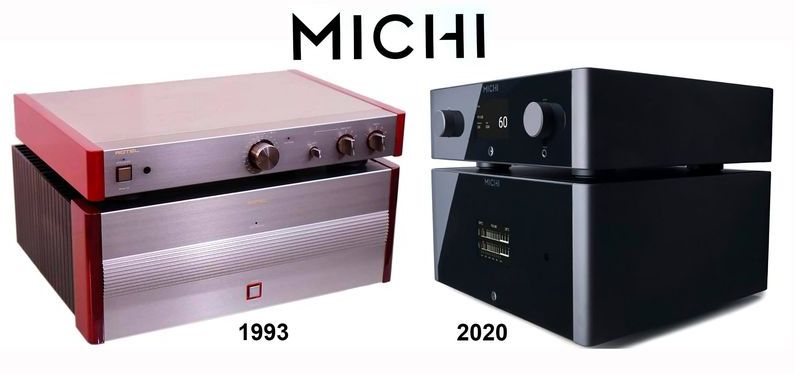 Black and violent - MICHI control and power
Black and violent - MICHI control and power
Michi
is back! Some may remember the beautiful Michi amplifiers from the 90s
with solid lacquered wooden sides and delicious finish. There was both
a preamplifier, RIAA and a power amplifier. I had at one point the
almost ultimate separate RIAA RHQ-10 on hand, but the seller jumped at
the last minute.
Michi is Rotel's version of high-end equipment.
Michi means "direction" or perhaps control. I interpret it in
the direction "up" towards the top and the best you can get. A bit like
TAD and Pioneer, where you choose to present the best you can make
under a different name. The new amplifiers from Michi have been under
development for 3 years in a dedicated department of the company.
Nowhere do you find the name "Rotel" mentioned. No, this is definitely
"MICHI". If the twice 500 Watt that the S5 put out does not provide
enough, there is also an M5 monamp, which provides approx. the double
output. It takes two to stereo.
P5 control and a complete solution
MICHI
P5 is a very large and heavy control amplifier. At 22.9 kg, it weighs
just as much as many integrated amplifiers. You need a solid shelf with
a depth of approx. 50 cm. Michi P5 stands in a pure black glossy design
only broken by a large display in the middle flanked by two appropriate
control buttons. The sides are a somewhat toned down metallic gray,
somewhat reminiscent of titanium. These sides also act as
heatsinks for the total of 17 separate power supplies.
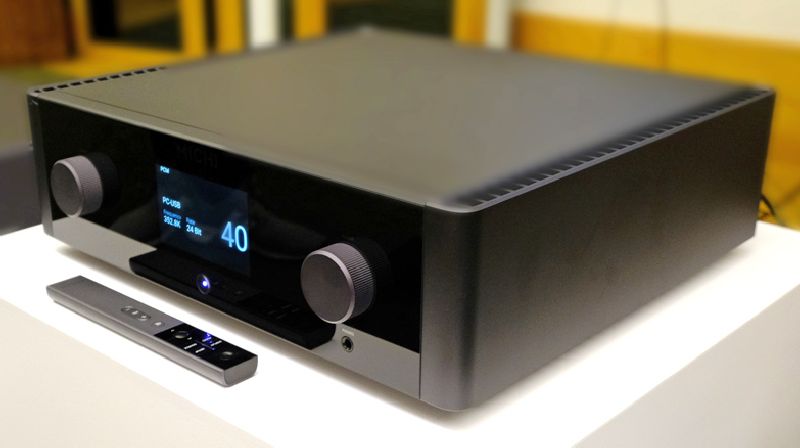 | 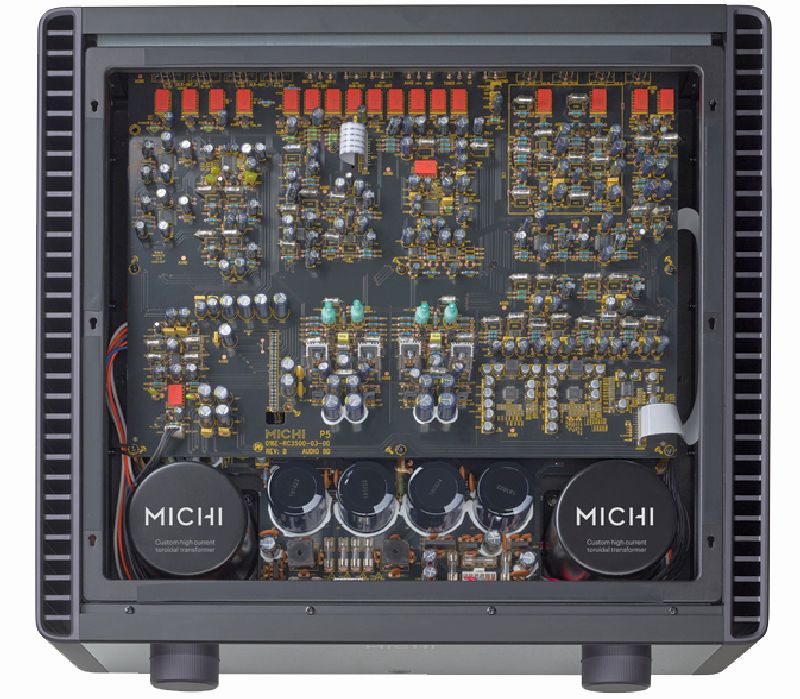 |
The
cabinet is completely filled upl, which is understandable when all the
many facilities are taken into account. There is a built-in DAC (AKM)
which via USB handles MQA and runs with 32 bit / 768 khz or DSD. In
addition, there is a built-in RIAA with MC-input. Internally the P5
circuit s unbalanced, but on both inputs and outputs there are XLR
connections (internal conversion). It does not have streaming, but
there is a LAN connection and bluetooth. A USB stick with Windows
driver is also included if you want to connect your PC. I connected my
Innuos Zenith Mk III via the USB input. After setting up Roon, there
was masic. However, not without problems, because if you choose
another input on P5, The USB is disconnected internally and Roon
interrupts the signal. In other words, you can not sit and select music
via your tablet when listening to another input.
In total there
are 7 analog inputs, 2 XLR, 5 RCA including RIAA. There is a fixed
level line output for e.g. tape recorders. On the digital side, as
mentioned, there are LAN, Bluetooth and USB, as well as 3 coax and 3
optical. On the output side, there are 2 RCA and 2 XLR as well as two
digital. There are also two mono subwoofer out. In addition, a number
of mini jacks for remote on / off of connected equipment. For a better
overview of all the many options, it is best to see the picture of the
back and all the terminals. As ut can be seen, it is completely filled
up.

Operation
One
quickly learns to appreciate the large display. However, it can be
switched off completely or via a timer function set to shut down after
a preselected number of seconds. I set it to 10 seconds, leaving the
menacing black shiny surface - great! Volume is indicated with large
clear numbers, while choice of input and possibly sample rates and
other settings are somewhat smaller. If there is no increased signal at
the selected input, P5 switches off after approx. 10 minutes. If you
have connected the S5 via minijack, it also switches off.
In the
setup you can change the names of the selected inputs, but you can also
deactivate inputs that you do not want to use, which makes operation
somewhat easier. Exactly around the selection of inputs, it happens in
a kind of submenu on the screen. When you have scrolled up and down to
the selected input, it takes a few seconds before the signal is opened.
Relatively easy directly on the amplifier, but to put it mildly
somewhat cumbersome on the remote control (see below). Indication of
selected input and possibly sample frequency is, as mentioned, a
somewhat smaller font. I, and a few more, could not see it from the
listening position. On the other hand, you get up from the chair a
few more times to change the input.
One thing that is
clearly mentioned in the manual is how the headphone output works. The
output signal is not interrupted when headphones are plugged in. You
must then switch off the connected power amplifier(s) before listening
to headphones. At the same time, you must also remember to turn the
volume down before switching them on again, as you typically have to
turn up much higher with headphones. The output otherwise gave an
excellent result via my Hifiman HE1000SE headphones, but not quite as
good a a dedicated headamp.
As
is now typical of many control amplifiers, the Michi P5 also has a
relatively high gain. It is expressed in a fine hiss in very efficient
speakers (95 to 100 dB sensitivity), Here you can insert a form of
attenuation between preamplifier and power amplifier, or if possible
attenuate the sensitivity of the latter. I would have liked to have
seen a switch or maybe an internal change of gain in the otherwise
impressive menu. Since it is all software controlled and there are
regular updates, it could be an upcoming option.
Briefly tried a few
other power amps. than the Michi S5. They needed a bit more gain
and there was not the same problem with noise.
The remote control
A
solid metal remote control is included with both devices. If you buy
the set P5 and S5, you have two. You can turn both devices on and off
via the remote control at the same time. In addition to the volume up
and down, there is a good mute function. At the top you will find four
buttons. "Display" changes function and brightness. Here you can also
choose to have the display in P5 switch off after a certain number of
seconds. On the power amplifier you can also switch between different
power displays or you can turn it off completely.
With "Audio" there
are various choices for the different inputs. For example. whether the
RIAA input should be MC or MM as well as tone controls and mono (which
I did not try). "Set up" selects several different functions. For
example. names of the individual entrances. Here it would be smart if
one could use the control button on the P5 or even better a connected
PC or tablet. It is very cumbersome with the small keys on the remote
control and there is no delete key?
Finally, there is the "Source"
function, which is used when selecting input. But with remote control
it is a bit complicated. The "Source" function is activated - the menu
is pressed up / down (if you can see it from the listening position) -
confirm with "Enter". So at least 3 keystrokes to select an input -
often several more. I often experienced some contact bumps, so I
instead went into a setup menu. Not very optimal. It should be possible
to make it smarter, but again… I got up from the chair!
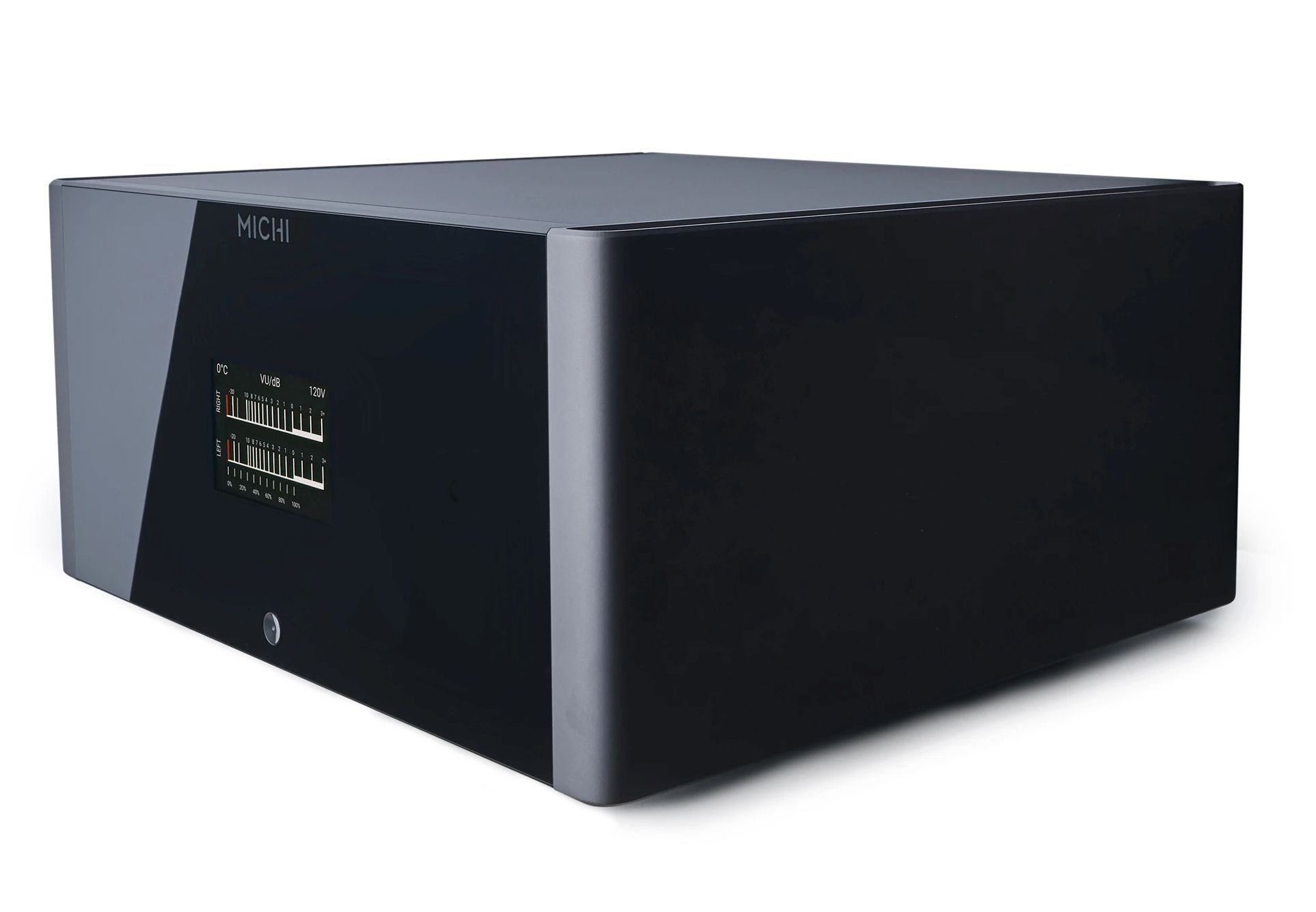 | 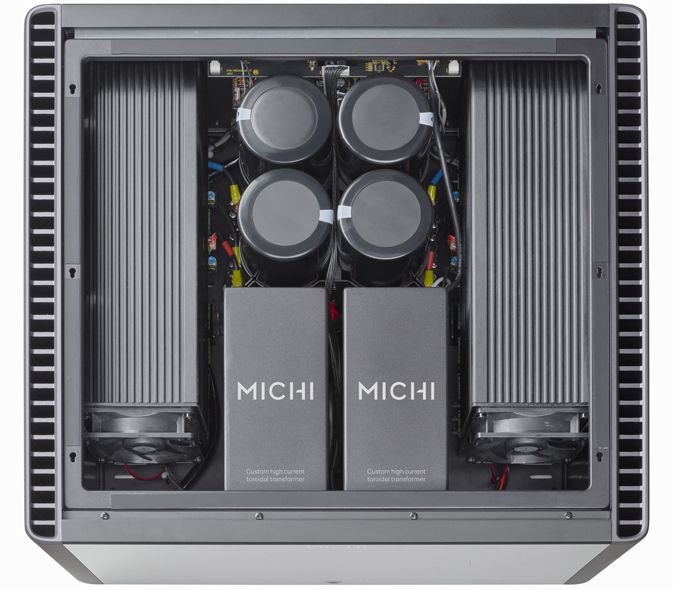 |
Michi S5 - heavy power
A
huge block of a power amplifier. The Michi S5 has an almost diabolical
appearance. "I can do anything" it says, just tell me what you want.
With
a combat weight of 60 kg and 2 x 500 watts output, it is an absolutely
competent power amp. In fact, there are two mono amps in the same box.
The power supplies for each channel consist of a 2,200 VA
toroid transformer and 2 x 47,000 uF capacitors. You can rightly
say "overkill". Despite this, the S5 is stated "only" for 2 x 800 Watts
in 4 ohms. Probably something power-limiting rather than the power
supply limits. In each of the two large cooling tunnels (which run very
silently with internal fans) there are 16 powerful output transistors.
In normal operation, the temperature was around 39 degrees, which is
shown in the large display. Michi informs about securing cooling around
the amplifier. At no point did I experience it getting hot. But in a
larger room and with more heavy-duty speakers, I would think it
may become topical.I got it up to a maximum of 40 degrees, but have
seen that others with large speakers in larger rooms can get it up
around the 45 degrees.
There are both RCA and XLR inputs. The
fact that the S5 is not internally balanced can also be seen from the
data - the gain on the RCA is 28 dB, while on the balanced it is only
24 dB. Somewhat more oddly, there is only 12.5 kohm impedance at the
RCA input and 100 kohm at the balanced one. If you use e.g. a
preamplifier with tubes, it is definitely something one just needs to
be aware of.
On the back you will also find dual speaker terminals,
switch between RCA and XLR, as well as network connection (LAN) and
minijack for control of on / off from P5 (see picture below).
At
first glance, it was my opinion that 2 x 500 Watt was more than ample,
but according to the impressive VU meter, I threw just below 200 Watt
peak into a pair of smaller 2-way speakers? No I did not. I had
unknowingly chosen 8 times the sensitivity in the VU meter on the
front, so in reality it was around 30 Watt peak. There are also
three other options; 4 times, 2 times and real value. But still, the
display shows well how much power you actually use. Normally, the
meters do not move much. With 87 dB / watt speakers, the 30 watts
corresponds to approx. 94 dB at the listening position. If I turn it up
really high, I might use 100 Watt in the peaks. If I were to need 500
Watts, the neighbors should probably just be warned first!
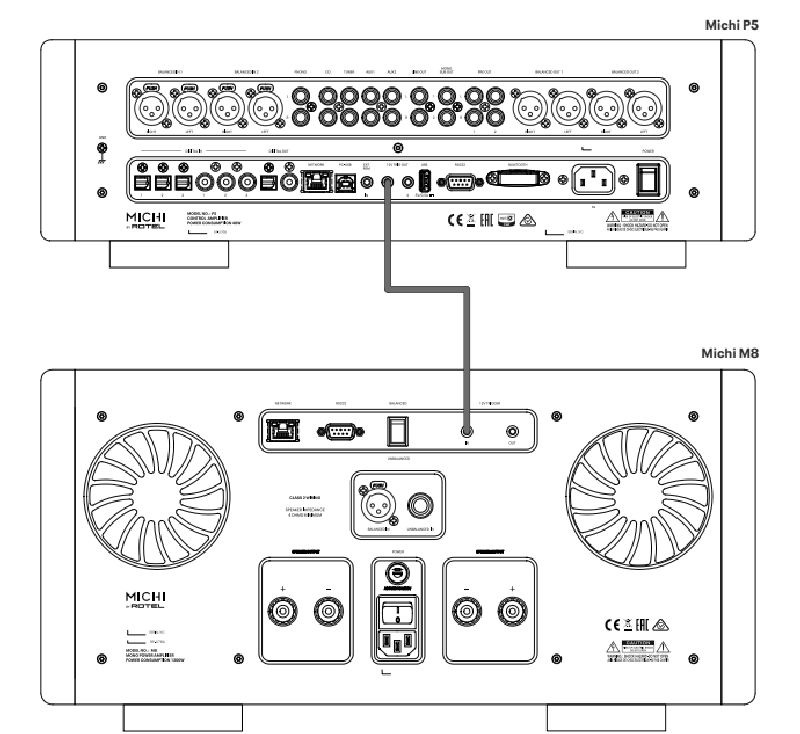 The sound of MICHI
The sound of MICHI
We
know the expression "A colossus on clay feet". Here it is almost the
opposite: "A heavyweight in dancing schoes". There is an immediacy and
lightness over the rendering. Details and a large open sound stage are
provided. It all depends to a large extent on signal wires and cables
as well as the speakers. All kinds of changes are revealed immediately.
I tried a lot of cables - both RCA and XLR balanced. Although there is
extra electronics in the balanced operation, it is not exactly audible.
However, I experienced a bit less noise via the XLR.
I started
out with my Innuos Zenith III connected via USB to P5. It immediately
acknowledged and confirmed the MQA signal. It also quickly became clear
that the built-in DAC is of high quality. DSD files and HD 24/192 were
also played smoothly. There were all the details I otherwise get from
my PS Audio Direct Stream DAC. Maybe a little more sober and with
somewhat less warmth, but still with all the details intact. The result
was that I subsequently sold my PS Audio and kept the P5. Yes, the
built-in DAC in the P5 does just fine with my needs. However, it is no
secret that the primary sources for me are analog - vinyl and tape
recorders.
I listened a lot to TIDAL hifi. For example. the new
one with Yello / Point (which I also heard from LP), offers lots
of bottom and good energy. A large uncompressed sound stage is provided
and good punch. At times with an almost frightening energy playing
with a high sound pressure level. Here, the power amplifier must count
in as it sounds absolute bottom less - no powerlimits. But P5 delivers
the signal and part of the controll. There are details and an overview.
The top octaves sountds great - no trends for accents or digital
colouration.
Another current favorite is Yusuf / Cat Stevens:
Tea for the Tillerman 2. I have fallen for this new interpretation,
where his voice has grown and shaped by time. The musicians he has
with him are definitely also of the first carat. A very captivating
record and especially the voice sounds great with a good fullness and
empathy. The Michi P5 certainly did not disappoint, but delivered a
delicious musical experience. There were control and details, so I
concentrated more on the music than assessing any shortcomings.
Finally, I also heard a bit of LPs but more on that in the following.
RIAA - MM and MC
With
the increasing popularity of the LPs, it is no wonder that Michi has
chosen to include a RIAA with both MM and MC input. In general I can
say that the RIAA has a fine reproduction, however not in the same
class as the DAC and not at all like my separate (and much more
expensive) Accuphase RIAA amplifier. MM is 47 kohm and the MC input I
measured to 100 ohms. It is not possible to change either capacity or
impedance. With my turntable and Glanz arm as well as Ikeda and other
pickups, the P5 was put on something of a task. In terms of sound, it
closes down a bit. In terms of level, it's very good, but it all sounds
a little less distinct and airy than I'm used to. The midrange is a bit
thin and lacks some weight and fullness. On the other hand, with the
2-3 MM pickups I tried, there was some more weight in the low
frequencies. There was a light focus on the great and powerful,with a
good weight in the sound that suits well especially pop and rock. On
the other hand, the low frequencies were not as detailed and the
soundscape was closer. 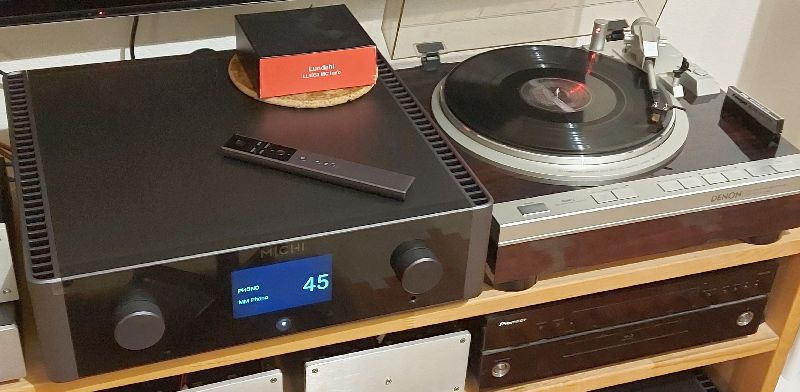 I
also tried out a newly purchased turntable. A used Denon DP-47F.
It got a better plate mat and was fitted with a Denon DL-1000A pickup.
A former top model from Denon and probably a little too much to demand
from the Michi MC input. The output is 0.12 mV, but in terms of
impedance it fit well enough. Apart from a bit of fine hiss (no hum),
this combination delivered an absolutely acceptable rendering. Sound
stage was somewhat smaller and not as stable as I have experienced it
from this excellent pickup. With a Lundahl LL 1933 transformer and
switch to MM, there was definitely an improvement. More control of
things and more hole through upwards. The midrange and voices were now
more stable and fuller. There was good attack on percussion. An
absolutely approved rendition that clearly shows that the Michi
RIAA is growing a bit with the task. But it also showedthat the MC
input does not have quite the same qualities as the MM.
I
also tried out a newly purchased turntable. A used Denon DP-47F.
It got a better plate mat and was fitted with a Denon DL-1000A pickup.
A former top model from Denon and probably a little too much to demand
from the Michi MC input. The output is 0.12 mV, but in terms of
impedance it fit well enough. Apart from a bit of fine hiss (no hum),
this combination delivered an absolutely acceptable rendering. Sound
stage was somewhat smaller and not as stable as I have experienced it
from this excellent pickup. With a Lundahl LL 1933 transformer and
switch to MM, there was definitely an improvement. More control of
things and more hole through upwards. The midrange and voices were now
more stable and fuller. There was good attack on percussion. An
absolutely approved rendition that clearly shows that the Michi
RIAA is growing a bit with the task. But it also showedthat the MC
input does not have quite the same qualities as the MM.
A
number of well-known records were played, but the most revealing was
classical in the form of "Espãna" with the London Symphony Orchestra in
an older Decca recording. Large space and lots of dynamics. Also nice
with details and air around the instruments. Not quite the firmness and
control I experience with my better turntable and RIAA, but still a
good experience. Yes, the Michi P5 can actually do well when it comes
to a good pickup and a transformer to help.
Probably a bit
unfair to compare Michi's RIAA with separates in the 5 digit price
range. I would say that the built-in RIAA in the P5 fits nicely with
e.g. a good Rega, Project, Thorens, Technics or the Denon I used.
Mounted with one of the better MM pickups, an excellent reproduction
can be achieved. For example, I got a fine result with my AT VM-95SH as
well as an older Shure V15 mk IV. A Denon DL-103 in the MC input I
could also imagine would be a good combination.
Streaming - Bluetooth
P5
does not have an actual streamer function. It has triggered some
criticism, which I do not understand. I connected my Samsung Galaxy Tab
S4 via bluetooth and it worked perfectly. Could play from Tidal hifi in
a surprisingly good quality - but not MQA. I have not before
experimented wireless transfer, but here I got the signal via WiFi
to Samsung and then to P5 via bluetooth. Well, an old man may be
impressed with all that new technology, but I still prefer a wired
connection!.Several radio channels were also brought in this way, which
I can definitely see the advantage in. Preserved ripped CDs from my
Innuos, I did not have access to this way, but the Bluetooth connection
must be able to make it out for a kind of streaming.
Tape recorders
I
also listened to my Technics RS1500 R2R with master tape as well
as my old (newly serviced) Pioneer CT-S910 cassette tape recorder. Here
P5 shows itself from the best side, even if an actual tape loop
does not exist. However, there is a fixed line output that can be used
for recordings from the selected source. However, you must remember not
to choose the tape input used, because then it will go absolutely
wrong, with a violent feedback.
Via the P5, I clearly heard the
limitations of the cassette tapes, although a recording on a Sony Metal
Master tape was impressive in many ways. The same recording on
reel-to-reel tape was a completely different experience. Ben
Webster from an "Analog Experience" reel-to-reel tape just added the
extra dimension that makes it fun. Definitely a reproduction, Michi P5
and S5 got through with all the details intact. A pleasure to listen to.
Conclusion
The
combination of P5 and S5 weighs 82 kg. Heavy hifi, which in terms of
price is nicely in the middle between the more common high-quality hifi
and then the very expensive high-end. Michi has managed to place these
amps in a place where you at a reasonable price get a quality that
can be called high-end. Hard to argue against the result of sound
quality and design. This is definitely true of the great power
amplifier that has really impressed me and I have barely put it to
serious tests yet. Lots of Power and with a detailed communication that
you otherwise only experience from small amplifiers. As previously
mentioned; "A heavyweight in dancing shoes".
P5 is a very
versatile preamplifier. There are many functions, but on the other
hand, it is also its strength. In terms of operation, I would have
liked to have seen slightly different solutions, but it is difficult to
satisfy everyone. Future software updates will hopefully offer some
improvements that make settings and operation a little easier.
I
have absolutely nothing to complaint about the sound. I am
impressed with the built-in DAC and the entire preamplifier section.
The MC / RIAA stage is absolutely approved. Primarily, the MM input
will be able to meet most requirements. The P5 does not run really
balanced, yet I experienced excellent rendering with the XLR connection
to the S5.
Overall, the Michi set offers so many features and
qualities that I have yet to try them all. On top of that, an
impressive sound quality. With this set, Michi has created an
absolutely listenable combination that powers all sources and all music
genres as well as drives even larger speakers in large rooms. When the
design also radiates strength and elegance, you can not really demand
any more. I have purchased the set and will in the future appreciate
and explore the qualities. But I also want to expand my rack, because
this is really heavy hifi!
For more information and user
comments, I can refer to the "Rotel Michi owners group" on FaceBook.
Here you will find lots of pictures and exchange of experience.